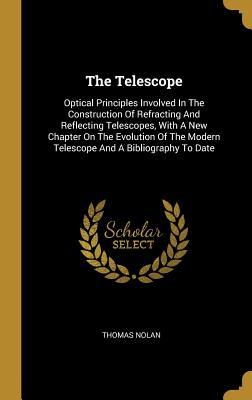Read The Telescope: Optical Principles Involved In The Construction Of Refracting And Reflecting Telescopes, With A New Chapter On The Evolution Of The Modern Telescope And A Bibliography To Date - Thomas Nolan | PDF
Related searches:
Ibn al-haytham made significant contributions to the principles of optics (and his famous book of optics), astronomy, mathematics, visual perception.
All telescope designs share certain basic principles of operations. Aperture and the focal plane, and orthogonal to them, defines the optical axis of the system.
They can be realized with refractive or reflective optics, or with a combination of those.
Jan 14, 2014 this exercise investigates the basic principles of geometric optics as compare optical aberrations of refracting and reflecting telescopes.
The short answer: early telescopes focused light using pieces of curved, clear glass, called lenses. However, most telescopes today use curved mirrors to gather.
The principle behind the refractive telescopes is the use of two glass lenses however, magnification is not the most important optical property for viewing.
The telescope is the single most important invention for astronomy. Without it, we would have little of the profound understanding we have obtained over the last few hundred years about the physical nature of the universe and its history. This lecture describes the main features of the design and operating principles of optical-band telescopes.
This page introduces the optical principles necessary to understand the design and performance of astronomical telescope systems — the telescope and eyepiece used as a visual instrument with the eye included as a third component.
You will note when using the keplerian telescope that the image is inverted.
A simple working telescope requires nothing more than a pair of lenses mounted in a tube. The lens in front, known as the objective lens, focuses an image; the lens in back, known as the eyepiece lens, magnifies that image. Although it may seem like a crude device, a simple telescope nicely illustrates the basic working.
(a) galileo made telescopes with a convex objective and a concave eyepiece. Flat mirrors are often employed in optical instruments to make them more.
Galileo heard of lipperhey’s work and reinvented the telescope, using basic optical principles. His first telescope magnified 3x and consisted of a convex lens and a concave lens fitted into opposite ends of a lead tube. The results were so gratifying that galileo made several larger telescopes, grinding his own lenses.
In 1609 an italian physicist and astronomer named galileo became the first person to point a telescope skyward. Although that telescope was small and the images fuzzy, galileo was able to make out mountains and craters on the moon, as well as a ribbon of diffuse light arching across the sky -- which would later be identified as our milky way galaxy.
Telescopes are generally understood to be optical instruments for viewing distant objects, as expressed by the greek words tele (far) and skopein (to view).
Aug 21, 2019 what are the parts of a telescope? a refractor is made up of a long tube containing lenses.
Buy the telescope: optical principles involved in the construction of refracting and reflecting telescopes, with a new chapter on the evolution of the modern telescope and a bibliography to date on amazon.
Telescope, device used to form magnified images of distant objects. The telescope is undoubtedly the most important investigative tool in astronomy. It provides a means of collecting and analyzing radiation from celestial objects, even those in the far reaches of the universe.
Although it may seem like a crude device, a simple telescope nicely illustrates the basic working principles of more powerful astronomical instruments.
A telescope is an optical instrument using lenses, curved mirrors, or a combination of both to observe distant objects, or various devices used to observe distant objects by their emission, absorption, or reflection of electromagnetic radiation.
Two pieces in a telescope make this possible: the objective lens (in refractors) or primary mirror (in reflectors) collects lots of light from a distant object and brings that light, or image, to a point or focus.
The lens near the eye, called the eye lens, acts as an ordinary magnifying glass to magnify that upside-down image.
A telescope is an amazing device that has the ability to make faraway objects this is the same principle that a magnifying glass (lens) uses; it takes a small.
Naturally, each of these optical principles can also be used in such things as light fixtures.
An optical telescope is a telescope that gathers and focuses light, mainly from the visible part of the electromagnetic spectrum, to create a magnified image for direct view, or to make a photograph, or to collect data through electronic image sensors. There are three primary types of optical telescope: refractors, which use lenses (dioptrics).
Let’s first study the different optical elements used today. I will keep the definitions as close as possible to the ones used in astronomical telescopes or even telescopes in general. Lens is an optical element which converges or diverges light.

Post Your Comments: